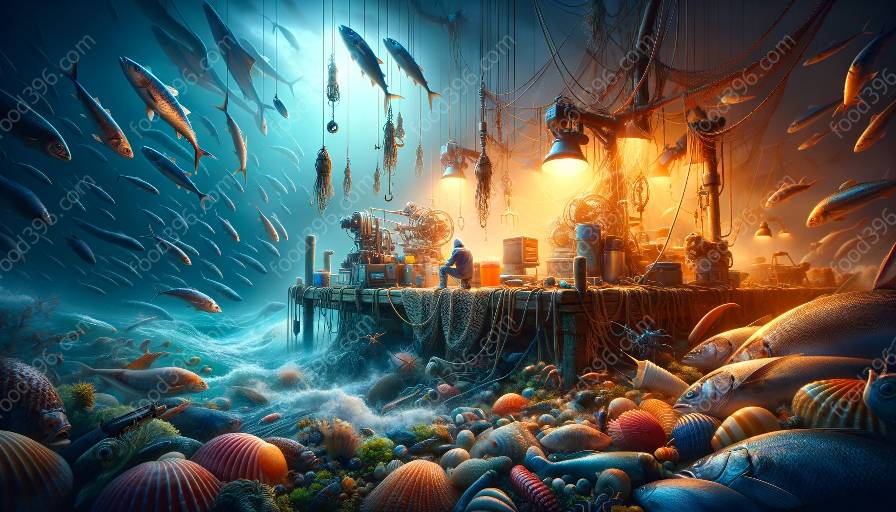Are you ready to dive into the fascinating world of fishing methods and techniques? In this comprehensive guide, we will explore various fishing methods and techniques and how they intersect with the realms of fishing technology, equipment, and seafood science.
Understanding Fishing Methods
Fishing is an ancient practice that has evolved over centuries, resulting in a wide array of fishing methods, each tailored to specific conditions and targets. Let's explore some of the most popular fishing methods:
Angling
Angling is one of the most beloved and widely practiced fishing methods around the world. It involves using a fishing rod, reel, and line to catch fish, often with the help of artificial lures or live bait. Anglers rely on their skill and knowledge of fish behavior to entice their prey.
Trawling
Commercial fishing often employs trawling, which involves pulling a large net through the water to catch fish and other marine creatures. Trawling can be done close to the surface or along the ocean floor, depending on the target species.
Longlining
Longlining is a method that uses a main line with multiple baited hooks attached at intervals. This method is commonly used to catch species like tuna, swordfish, and halibut.
Gillnetting
Gillnetting involves setting a wall of netting in the water that catches fish by their gills. This method is often used for species like salmon and herring.
Trapping
Trapping involves setting traps or pots in the water to capture fish, crustaceans, or mollusks. This method is commonly used for species like lobsters and crabs.
Techniques for Successful Fishing
While understanding the various fishing methods is essential, mastering the techniques that accompany them is equally important for a successful catch. Here are some essential fishing techniques:
Casting
For anglers, mastering the art of casting is crucial. Whether it's a delicate presentation in freshwater or a long, accurate cast in saltwater, proper casting techniques can make all the difference in enticing a fish to strike.
Bait Presentation
How the bait or lure is presented to the fish greatly impacts the chances of a successful catch. Anglers and commercial fishermen carefully consider the depth, speed, and movement of the bait to attract their target species.
Setting and Retrieving Gear
When using methods like trawling, longlining, or gillnetting, knowing how to effectively set and retrieve gear is essential. Proper techniques ensure that the gear is operated efficiently and minimizes the impact on the marine environment.
Integration with Fishing Technology and Equipment
The world of fishing constantly experiences advancements in technology and equipment, revolutionizing the way fishing methods and techniques are practiced. Let's explore the integration of fishing methods with technology and equipment:
Sonar and Fish Finders
Modern anglers and commercial fishermen rely on sonar and fish finders to locate schools of fish and understand their behavior. These technologies enhance the efficiency and success of various fishing methods.
GPS and Navigation Systems
Accurate navigation is crucial for successful fishing expeditions. GPS and navigation systems enable fishermen to pinpoint productive fishing grounds and navigate safely, optimizing the effectiveness of different fishing methods.
Fishing Gear Innovation
From advanced fishing rods and reels to specialized nets and traps, innovative fishing gear plays a pivotal role in enhancing the performance of fishing methods. Materials and designs are continually evolving to improve durability, functionality, and sustainability.
Exploring Seafood Science
The world of fishing methods and techniques is intricately connected with seafood science, which encompasses the study of fish and other marine life as a food source. As fishing practices continue to evolve, seafood science plays a vital role in understanding and managing marine resources.
Sustainable Fishing Practices
Seafood science contributes to the development of sustainable fishing practices by studying the biology, behavior, and population dynamics of various fish species. This knowledge informs regulations and management strategies that aim to maintain healthy fish populations and ecosystems for the future.
Fish Handling and Quality
Advancements in seafood science have led to improved techniques for handling and preserving fish from the moment they are caught to the point of consumption. This ensures that consumers receive high-quality seafood products while minimizing waste and environmental impact.
Nutritional Benefits of Seafood
Seafood science delves into the nutritional composition and health benefits of different fish species, contributing to a better understanding of how seafood can be incorporated into a healthy diet.
Conclusion
From the art of angling to the precision of commercial fishing methods, the world of fishing methods and techniques is a fascinating tapestry of tradition, innovation, and science. By understanding the interplay between fishing technology, equipment, and seafood science, anglers, commercial fishermen, and seafood enthusiasts can deepen their appreciation of the dynamic connection between humans and the aquatic world.

